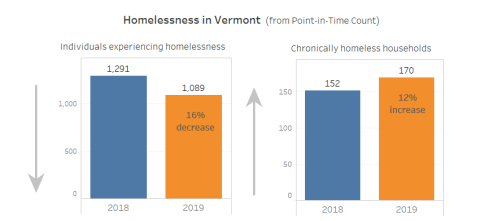Newly released data from the 2019 Point-in-Time Count showed 1,089 people experiencing homelessness in Vermont on a single evening this winter, which represents a 16 percent decrease from last year. However, the number of chronically homeless Vermonters increased substantially from 2018 to 2019, prompting concerns that existing services may be inadequate to support homeless households.

The data comes from the Point-in-Time (PIT) Count on January 23rd conducted by the Vermont Coalition to End Homelessness and the Chittenden County Homeless Alliance. The annual survey attempts to count homeless individuals and families, including people in shelters, transitional housing, hotel rooms purchased using public funding or living outdoors. It does not count those at risk of homelessness or temporarily living with friends or family. Although the PIT count is the one of the best sources available, it inevitably underrepresents the total extent of homelessness in our state. In 2017, the total number of homeless individuals who received services throughout the calendar year was roughly three times the number counted in the PIT count.
There were many signs of progress in the 2019 PIT results, with a decrease from 2018 in the number of homeless children, families, veterans and households fleeing domestic violence. At the same time, the number of both chronically homeless households grew from 152 to 170 and the number of unsheltered households increased from 63 to 102. Chronic homelessness describes people who have experienced homelessness for at least a year while struggling with conditions including serious mental illness, substance use disorder, or physical disability.
Permanent supportive housing, which pairs affordable housing with case management and supportive services, is essential for addressing chronic homelessness. The number of new apartments built to provide permanent supportive housing has been increasing in Vermont over the past several years, but funding for supportive services has not kept pace. Since 2012, Vermont has missed out on approximately $1.4 million in rental assistance for homeless and at-risk households, due to the inability to match households with local service providers, many of whom lack the capacity to serve additional households.
Completely ending homelessness in our communities will require increased investment in social services to support vulnerable, high-needs households.
